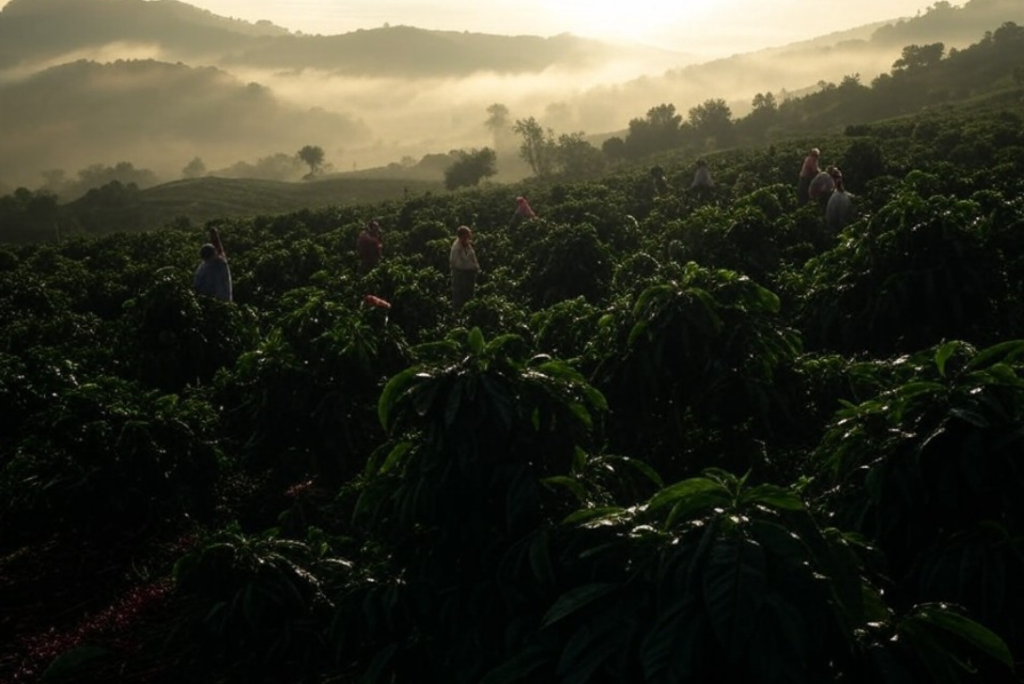
Artisanal Rituals for a Memorable Customer Experience
How can brands create a more balanced and memorable customer experience by blending artisanal product quality with thoughtful everyday rituals that keep people coming back?

Sustainable coffee farming practices focus on creating a positive impact on the environment while ensuring the longevity of coffee farms and the well-being of farming communities. They involve various methods such as:
Coffee is more than a beloved beverage—it’s a livelihood for millions around the world. As the industry faces environmental challenges, everything from shade-grown techniques to organic farming plays a key role in protecting fragile ecosystems.
In a time when ethical and environmentally friendly practices are essential, integrating sustainable coffee farming practices ensures not just a better cup of coffee but a better future for our planet.

Simple Sustainable coffee farming practices glossary:
Coffee farming has come a long way from its origins, evolving in response to environmental and social needs. Let’s explore how sustainable coffee farming practices have developed over time.
In the early days, coffee was grown using traditional methods that were inherently sustainable. Indigenous communities in Ethiopia, for instance, cultivated coffee under the shade of native trees. This method, known as shade-grown coffee, helped preserve biodiversity and maintain soil health. By keeping the natural ecosystem intact, these early farmers ensured that their coffee plants thrived without harming the environment.
As coffee demand grew in the 19th and early 20th centuries, so did the practice of monoculture farming. Large-scale plantations focused on maximizing output led to significant deforestation and soil degradation. The use of chemical pesticides became common, creating ecological and social challenges. This shift marked a departure from the sustainable practices of the past, prioritizing quantity over environmental health.
The late 20th century saw the emergence of certification programs aimed at promoting ethical and sustainable coffee production. Fair Trade and Rainforest Alliance certifications were introduced in the 1990s, offering consumers a way to support more responsible coffee farming. These programs set standards for safe working conditions, livable wages, and eco-friendly farming methods.

Certification programs like Fair Trade help ensure that farmers receive fair compensation for their work. They also promote sustainable practices that protect the environment and support local communities.
As consumers became more aware of the environmental impact of their choices, these certifications gained popularity. They encouraged coffee producers to adopt methods that were not only better for the planet but also beneficial for the people involved in the coffee supply chain.
In recent years, the coffee industry has acceptd regenerative agriculture, a practice that focuses on restoring ecosystems and improving soil health. This approach is seen as a solution to the challenges posed by climate change, with companies and farmers working together to create a more sustainable future.
As we look to the future, the journey of sustainable coffee farming continues. By learning from traditional practices and adopting modern innovations, the coffee industry can thrive in harmony with nature.
Next, we’ll dive deeper into key sustainable coffee farming practices that are making a difference today.
Sustainable coffee farming is all about balancing production with environmental care. Here are some key practices that are helping farmers achieve this balance:
Shade-grown coffee is a method where coffee plants grow under a canopy of trees. This practice mimics the coffee plant’s natural habitat and offers several advantages:

Agroforestry combines coffee cultivation with other trees and plants. This approach has multiple benefits:
Organic farming avoids synthetic fertilizers and pesticides, relying on natural processes to maintain soil and plant health:
Water is crucial in coffee farming, and sustainable practices ensure its efficient use:
Soil is the foundation of any farming operation. Sustainable practices keep it healthy and productive:
By integrating these sustainable coffee farming practices, farmers are not only protecting the environment but also enhancing the quality of their coffee. This approach ensures that coffee farming remains viable for generations to come.
Sustainable coffee farming offers a range of benefits that go beyond just producing a good cup of coffee. Let’s explore how these practices contribute to biodiversity conservation, climate change mitigation, and economic sustainability.
Biodiversity is crucial for a balanced ecosystem. Sustainable practices like shade-grown coffee and agroforestry help maintain this balance.

Coffee farming can play a role in fighting climate change. Sustainable practices contribute to reducing the carbon footprint of coffee production.
Economic sustainability ensures that coffee farming remains viable for farmers and communities.
Sustainable coffee farming practices not only protect the planet but also secure the future of coffee production. They support biodiversity, help mitigate climate change, and ensure economic benefits for farmers. As we explore further, these practices are integral to adapting to climate challenges and maintaining the coffee industry’s sustainability.
Sustainable coffee farming practices are essential in addressing climate change. These practices focus on reducing the carbon footprint, promoting regenerative agriculture, and implementing agroforestry techniques.
Coffee farming can significantly impact the environment. However, adopting sustainable practices can help reduce this impact.
Carbon Sequestration: Coffee farms using shade-grown methods or agroforestry systems have trees that act as carbon sinks, absorbing CO2 from the atmosphere. This helps in lowering the overall greenhouse gas emissions.
Reduced Chemical Use: Organic farming avoids synthetic fertilizers and pesticides, which are major sources of emissions. This not only cuts down on carbon footprint but also improves soil health.

Regenerative agriculture is a key approach in sustainable coffee farming that focuses on restoring and enhancing the natural ecosystem.
Soil Health: Techniques like composting and crop rotation improve soil fertility and structure. Healthy soil can store more carbon, further reducing emissions.
Biodiversity: Regenerative methods encourage diverse plant and animal life, creating a balanced ecosystem that is more resilient to climate change.
Water Conservation: Efficient water management practices, such as rainwater harvesting, are integral to regenerative agriculture, reducing water usage and preventing soil erosion.
Agroforestry combines agriculture with tree cultivation, offering multiple benefits for climate change mitigation.
Diverse Ecosystems: By integrating trees with coffee crops, agroforestry supports diverse ecosystems. This diversity improves resilience against pests and diseases, reducing the need for chemical interventions.
Additional Income: Farmers can harvest timber, fruits, and other products alongside coffee. This diversified income stream helps offset the risks associated with climate variability.
Climate Resilience: The presence of trees in agroforestry systems helps regulate microclimates, protecting coffee plants from extreme weather conditions.
Sustainable coffee farming practices are not just about maintaining the quality of your morning brew. They are vital in reducing the industry’s carbon footprint and adapting to climate change, ensuring that coffee farming remains viable for future generations.
Sustainable coffee farming practices focus on protecting the environment, supporting local communities, and producing high-quality coffee. A key method is shade-grown coffee, where coffee plants are cultivated under a canopy of trees. This practice helps preserve biodiversity by providing habitats for various species and offers natural pest control. Additionally, growing coffee in the shade enhances the coffee’s flavor profile, as the slower maturation process allows for the development of more complex flavors.
Organic farming is another key practice. It avoids synthetic pesticides and fertilizers, focusing instead on natural alternatives. This not only protects the soil and water but also ensures that the coffee is free from harmful chemicals. Farmers practicing organic farming often receive certifications that can help them access premium markets.
Agroforestry is a powerful technique for sustainable coffee farming. It involves growing coffee alongside trees and other crops, creating a diverse and resilient ecosystem. This practice not only improves soil health and sequesters carbon but also provides farmers with additional sources of income, such as fruits and timber.
Water conservation is crucial in sustainable coffee farming. Traditional coffee processing uses a lot of water, but innovative methods like rainwater harvesting and efficient irrigation systems help reduce water usage. These techniques ensure that coffee farming remains viable even in areas facing water scarcity.
When it comes to brewing, using a French press or making cold brew coffee are considered sustainable methods. The French press doesn’t require paper filters, reducing waste. It also doesn’t need electricity, unlike some other coffee makers. Cold brew, on the other hand, uses time instead of heat to extract flavors, which can save energy. Both methods highlight the natural flavors of the coffee, especially when using high-quality beans like those from Equipoise Coffee’s selection, such as the Ethiopian Yirgacheffe or the Mexican La Laja Honey.
These sustainable practices in farming and brewing not only help the environment but also improve your coffee experience. By choosing these methods, you support a healthier planet and enjoy a better brew.
Equipoise Coffee is committed to offering a smooth coffee experience through ethical sourcing and sustainable practices. By focusing on sustainable coffee farming practices, they ensure that each cup not only tastes great but also contributes positively to the environment and local communities.
Their approach to ethical sourcing means working directly with farmers who use practices like shade-grown coffee and agroforestry. This not only supports biodiversity but also improves the unique flavors of each bean. For example, their Ethiopian Yirgacheffe offers bright, fruity notes, while the Mexican La Laja Honey provides a rich and smooth taste. These flavors are a testament to how sustainable practices can bring out the best in coffee.
Equipoise Coffee’s precise roasting process further amplifies these natural flavors, ensuring a balanced cup without bitterness. This dedication to quality and sustainability reflects their core philosophy: from bean to cup, every step is crafted to offer a superior coffee experience.
By choosing Equipoise Coffee, you’re not just enjoying a delicious brew; you’re also supporting a company that values ethical practices and environmental stewardship. Experience the perfect balance in every sip and explore their selection here.

How can brands create a more balanced and memorable customer experience by blending artisanal product quality with thoughtful everyday rituals that keep people coming back?

Independent coffee shops have always been about more than caffeine—they’re hubs of creativity, connection, and care. As café culture continues to evolve, new trends are

Introduction Independent cafes win when they feel like the neighborhood’s living room and operate with the discipline of a great kitchen. Below is a quick

Discover how top specialty coffee brands create lasting loyalty through storytelling, sourcing, and community connection. Real tips from 6 industry experts.

Discover the ultimate showdown between two beloved coffee brewing methods: the French press and Chemex. Explore how each technique caters to distinct palates, with the French press delivering bold flavors and the Chemex presenting a bright, clean taste.

Unlock the secrets to brewing the perfect cup of coffee with our comprehensive guide on using a coffee scale. Discover how precise measurements enhance flavor and consistency while eliminating bitterness.

Discover how water temperature plays a vital role in brewing the perfect cup of coffee. This article delves into the ideal temperature range of 195°F to 205°F for optimal flavor extraction, enhancing the enjoyment of high-quality beans.

Discover the world of curated specialty coffee bundles, perfect for enthusiasts seeking quality and craftsmanship. This article explores the benefits of ethically sourced, small-batch beans from brands like Equipoise Coffee, offering diverse flavor profiles that elevate your brewing experience.

Discover the art of manual brewing to elevate your coffee experience! This article explores various techniques like pour-over, French press, and AeroPress, revealing how they enhance flavor and your connection to every cup.